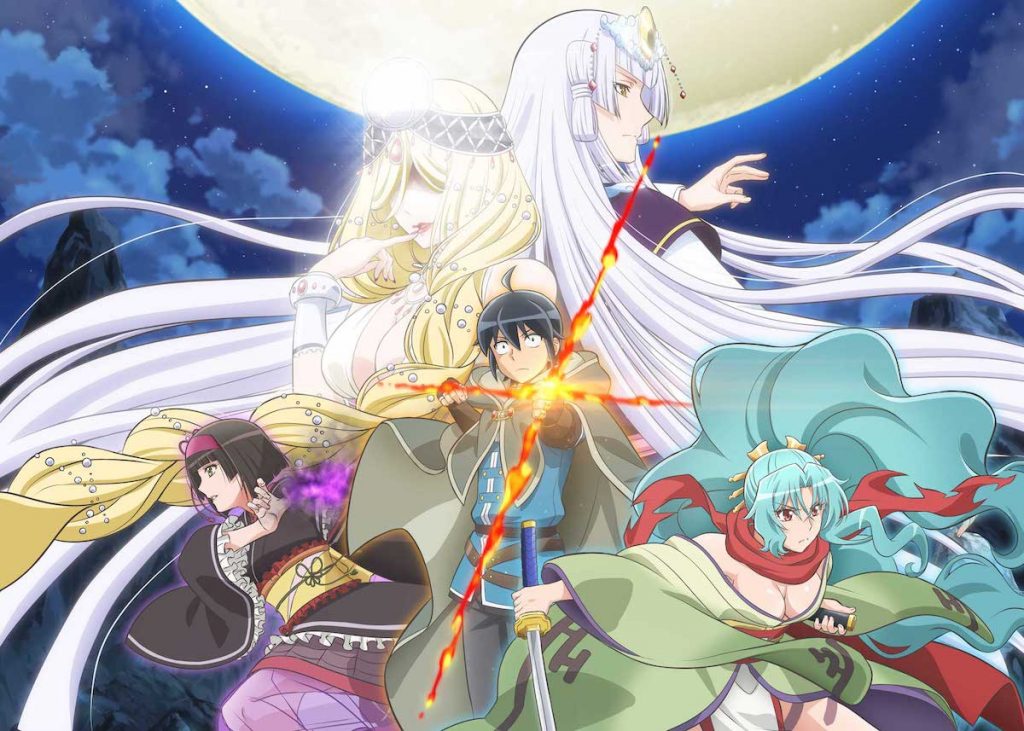
After more than 35 years of operation, TBI is closing its doors and our website will no longer be updated daily. Thank you for all of your support.
TBI Weekly: Harnessing anime’s subscription-driving power
TBI deputy editor Mark Layton digs into what is driving rising global demand for anime and how streamers can make the most of the medium’s passionate fanbase.
Global demand for Japanese anime content is skyrocketing, with streamers worldwide increasingly recognising the appeal – and subscription-driving potential – of this medium, once seen as niche, but now unquestionably widespread.
It’s been hard to miss the heavy investment from the likes of Netflix and others in acquiring anime or commissioning their own content the past couple of years. Meanwhile, if ever a demonstration of anime’s international resonance was required, the feature film, Demon Slayer -Kimetsu No Yaiba- The Movie: Mugen Train, succinctly proved the point by storming the global box office last year, earning over $500m to become the most financially successful film of 2020 worldwide – quite a feat during a pandemic.
Raising the bar
“More money is pouring into anime production, with a main catalyst being Netflix’s growing prominence, which has in turn elevated the overall quality of works being created,” explains Kako Kuwahara, Nippon TV’s EVP of business development, highlighting some of the major factors leading to anime’s current heyday.
“From the viewers’ perspective, the emergence of technology that enables simultaneous streaming all over the world, the increase of translation apps, and social media have created the ideal situation that allows them, wherever they may be, to enjoy the same titles while sharing their thoughts.”
Tokyo-based Nippon TV has been producing, broadcasting and distributing anime both domestically and internationally for decades, with shows such as My Hero Academia, Death Note and LUPIN THE 3rd among its titles, but it was just last October that the company set up a dedicated anime department, headed by Kuwahara.
The unit launched with an adaptation of Kei Azumi’s manga Tsukimichi – Moonlit Fantasy, produced by C2C Studios, with global rights snapped up by anime streamer Crunchyroll, and a worldwide release is due next month.
Upcoming offerings from the division include LUPIN THE 3rd PART6, the latest instalment in the long-running series, which is being produced by TMS Entertainment and will be released in October to mark the show’s 50th anniversary. Like the Netflix live-action series Lupin, both are inspired by the adventures of French writer Maurice Leblanc’s literary gentleman thief Arsène Lupin.
Kuwahara explains that the success of the Demon Slayer movie, which serves as a sequel to the series of that name, has “raised the bar” and highlighted the “allure of Japanese anime all over again.” Consequently, Kuwahara says that the nascent anime department was met with “immense” international demand for content right from the get-go.
“The environment was already favourable with globally-eminent players increasingly eager to commission projects, and the offers we receive are sometimes even higher than we expect.
“We also receive exciting proposals to invest in our content. An overseas partner agreed to fund a title three years before the release, and we now have the framework to pursue game adaptations, merchandise, and comicalisation as well. Indeed, the volume of anime that Nippon TV produces and distributes is increasing rapidly.”
Bringing classic shows to new audiences
Amazon Prime Video is among those globe-spanning streaming services whose expansion has undoubtedly contributed to a renewed awareness and interest in classic anime titles and a subsequent demand for new content.
The streamer carries around 70-100 anime titles at any one time, such as Vinland Saga and Dororo, as well as two originals – historical action Blade Of The Immortal and comedy series Crayon Shin-chan Spin-off.
As Martin Backlund, Prime Video’s head of content for the UK, Ireland and Nordics, explains: “Anime has always had a rich storytelling history, but until recently the genre hadn’t been as exposed to international audiences. The growth of global streaming services has given the audience access to troves of iconic anime stories and exposed them to younger audiences often for the first time.”
Backlund says that without the constraints of a programming schedule, streamers like Prime Video are able to provide a broad content offering and cater to audiences looking for “previously lesser-known genres” like anime.
“Additionally, the distribution channel allows us to deliver high quality subtitled or dubbed content, which has eliminated the language barriers that historically existed for all but the most popular titles.”
Backlund adds that Prime Video has “certainly seen increased engagement with anime on our service,” which he says has spurred further content investment to meet the growing demand.
“Our content strategy is based on listening to our audiences in order to bring them the most resonant titles. This includes developing franchise-based Amazon Originals like Blade Of The Immortal and the Crayon Shin-chan Spin-off as well as licencing well-loved anime classics.”
Backlund explains that as a global service, Prime Video tailors its approach to anime, as with all its content, to its local audiences: “In addition to our team in Japan, for whom anime is a significant focus, our local Prime Video content teams also pay close attention to the genre and the local audience to ensure we do not take a one size fits all approach.”
The streamer, he reveals, also sees the potential in more directly engaging with the its anime fanbase: “We are also investing in deepening our relationship with our anime fans. We recently premiered our first anime-centred IGTV show called The Animation Conversation which has given us the opportunity to strengthen our relationship with our anime audience.”
Engaging with the audience
One local player firmly seizing the potential in anime is Dubai-based Starzplay, which, seeing a gap in the market, declared itself the region’s “home of anime” in February, following a deal with the TV Tokyo Corporation.
The SVOD, which streams Arabic and Hollywood content to 20 countries across MENA and Pakistan, expanded its existing anime offering by more than a thousand hours, including the hit Naruto action franchise and romantic comedy Fruits Basket.
Starzplay CEO Maaz Sheikh reveals his confidence in anime content was greatly bolstered after initially testing the waters last year, by acquiring both the streaming rights to the latest season of superhero show My Hero Academia, which had been the most popular anime of 2020, as well as theatrical rights to its movie spin-off, and launching both at the same time.
“We were quite surprised, almost shocked, at how well it did and so from that point on kept building on that strategy,” says Sheikh, adding they were quickly bowled over by the great demand for anime in the region.
“The passion for anime in this part of the world is crazy. People learn Japanese just so they can watch anime simulcast the same time as Japan.” Specifically, Starzplay’s highest anime consumption comes from Saudi Arabia, with Fruits Basket doing particularly well there, while Egypt is also “a big fan of anime.”
As well as currently simulcasting three titles – My Hero Academia, Kingdom and Fruits Basket – with Japan, Starzplay’s large boxset offering has allowed it to localise content by dubbing into three Arabic dialects – a decision made following a fan engagement campaign.
Sheikh reveals that audience engagement around Starzplay’s anime content far outstrips any other type of content shown on the platform, while Khaled Benchouche, SVP of strategy & original content at the streamer, describes the region’s community of anime fans as “mindblowing”.
Benchouche further echoes Kuwahara and Backlund’s points about anime’s rising global popularity being aided by the growing ease of simulcasting, localisation and social media interaction – both between the fans themselves and with services that show anime content. He also highlights anime series as having strong storytelling that appeals to viewers in the territory as they don’t require understanding of western contextual references.
Sheikh and Benchouche further add that while the MENA region has a very young population, estimating almost 75% under the age of 30, anime content is not just appealing to the younger demographic it may be traditionally associated with, but also people in their 40s and upwards who grew up watching such shows.
Benchouche highlights two series from the 1980s in particular: “One is Grendizer and the other is Captain Tsubasa; here it was called Captain Majid. The fact that they even created opening credits in Arabic made those shows so popular and now they are the reference for anime in the region.”
He explains that this slightly older audience appears just as interested in newer shows – particularly from the shōnen genre – that remind them of the series they used to watch. “Now you have this new generation of anime, with Naruto or My Hero Academia, that we’re licensing simulcast with Japan. We offer each episode less than two hours after it is broadcast in Japan, subtitled in Arabic. We’ve created this offering for this new generation, but also the old generation, and this is why we can cater from 12 up to even 40-year-olds.”
Moving into the mainstream
It appears difficult to discuss the current rise of anime without also addressing its passionate fandom, and it seems clear that there are big opportunities for streamers that further leverage their content by fully engaging with those communities.
This is something that Colin Decker, CEO of global anime-focused business Funimation, well appreciates: “We must profoundly understand this customer, our community, in a way that many industries simply do not have to do.
“I do believe that is the future of business on just about every level. There’s a lot more room in the world for what I would call communities of interest, or category-specific things, not because of the content, but because of the community itself,” says Decker, suggesting many anime fans are drawn simply to the medium of anime rather than just specific shows.
Culver City-based Funimation is a joint venture of Sony Pictures Television and Sony Music Japan/Aniplex and a global distributor of anime, including titles such as Dragon Ball, Attack On Titan, Cowboy Bebop and Fullmetal Alchemist.
Its SVOD service offers a growing catalogue of more than 700 anime series and 13,000 hours of content available in 52 countries dubbed into six languages, having just expanded further into Latin America. It bills itself as a specialist in simuldubbing, with more than 600 voice actors dubbing anime content into English sometimes as soon as the same day of the original Japanese broadcast.
The company’s other pillars of business include theatrical releases and home entertainment and last year it held its first virtual FunimationCon 2020, making deep in-roads into community engagement.
Digging deeper into this fandom, Decker highlights that the anime community is “very much about identity” and “highly inclusive” with content over-indexing with minority groups, the LGBTQ community, and “any group that is perhaps slightly outside the mainstream”.
At the same time, Funimation was also the US distributor for the Demon Slayer movie, with Decker noting that it was “officially the number one movie of 2020 globally; so I’d say that’s pretty mainstream.” The service this week also took streaming rights to the feature for the US, Canada, Australia and New Zealand.
Incidentally, Decker points out that while anime might be in the spotlight right now, its community has been around “since arguably after World War Two” and, picking up on that recurring thread of a streaming and social media-led boost, explains: “In other words, it’s not new. What has changed over time is the ways in which they can receive and consume anime, but also equally as important are the different ways that they can connect with one another and kind of just get a sense of who else is in to it.”
Funimation is certainly set to keep building its community and upon its successes, with Sony buying WarnerMedia-owned anime streamer Crunchyroll for almost $1.2bn last year, and the service, which claims three million paying subscribers, being incorporated into Funimation.
The deal includes streaming rights to more than 1,000 anime titles and the acquisition will turn Funimation into the largest anime-dedicated streaming service in the world.
While the sale is currently under regulatory review, Decker assures TBI that it “will close” and has high expectations of what the future has in store: “The net result of this is something that will be in every way pro-anime and pro-customer and pro-fan. This is something that really has the potential to bring so much more value to fans of anime and reach so many more people.”
From these conversations, at least, it seems clear that the production and distribution of anime is only set to further expand in the coming years, particularly as regional audiences continue to gain access to proven shows just waiting to be localised – and demand for more and new, original shows rises. Those streamers willing to take that extra step and fully engage with this passionate audience may well find a subscription-driving fanbase switching on, looking to consume a range of content from across the medium.











